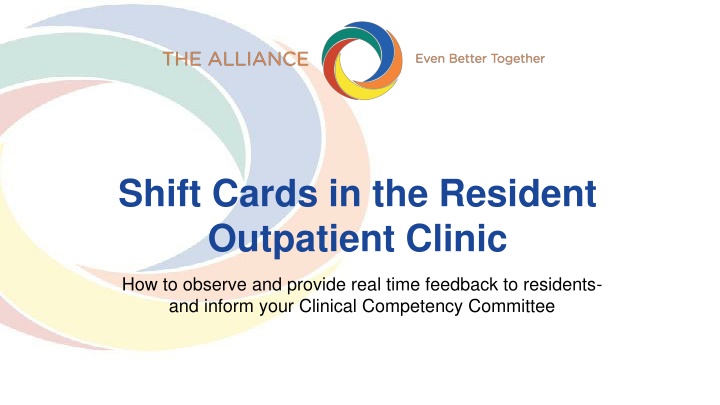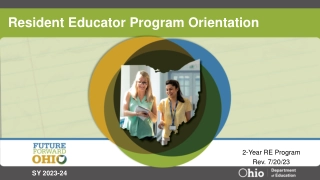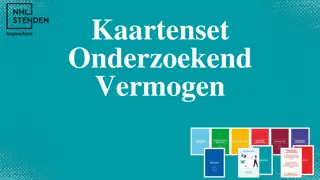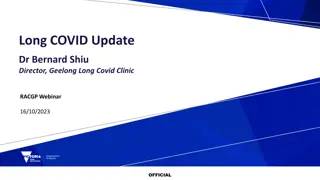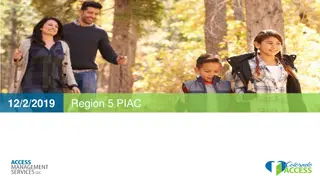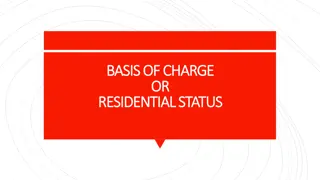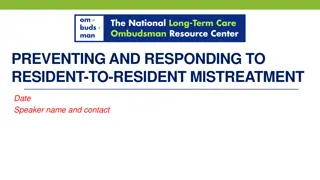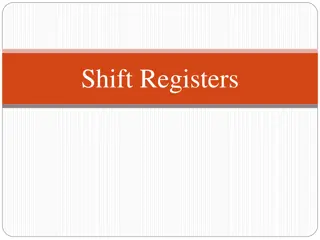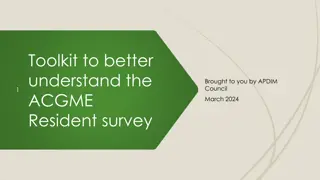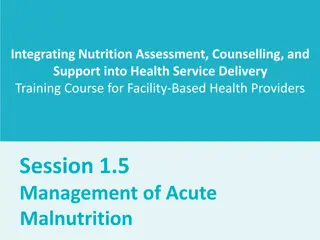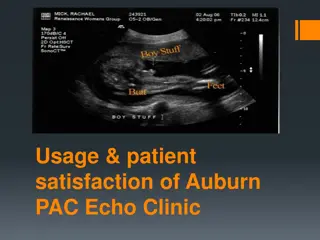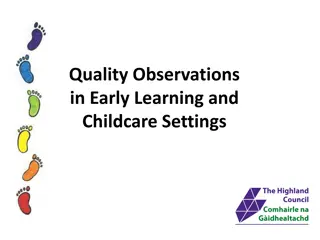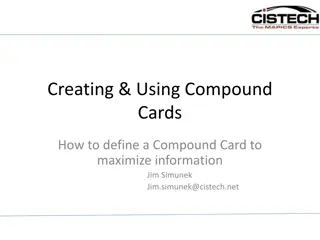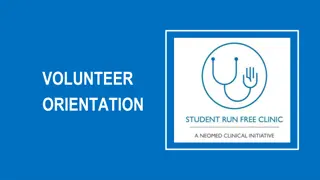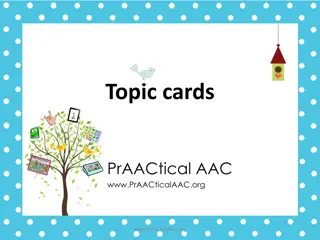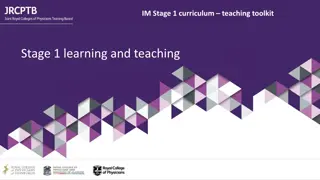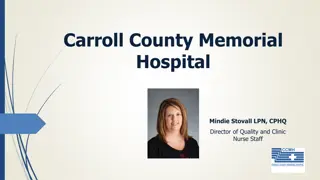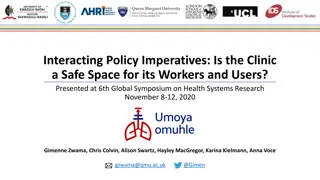Enhancing Resident Observations with Shift Cards in Outpatient Clinic
Explore the utility of Shift Cards in providing real-time feedback to residents in the outpatient clinic setting. Learn how to observe, provide feedback, and engage with the Clinical Competency Committee effectively using this innovative tool. Discover the benefits, learning objectives, and audience for implementing Shift Cards in medical education.
Download Presentation

Please find below an Image/Link to download the presentation.
The content on the website is provided AS IS for your information and personal use only. It may not be sold, licensed, or shared on other websites without obtaining consent from the author.If you encounter any issues during the download, it is possible that the publisher has removed the file from their server.
You are allowed to download the files provided on this website for personal or commercial use, subject to the condition that they are used lawfully. All files are the property of their respective owners.
The content on the website is provided AS IS for your information and personal use only. It may not be sold, licensed, or shared on other websites without obtaining consent from the author.
E N D
Presentation Transcript
Shift Cards in the Resident Outpatient Clinic How to observe and provide real time feedback to residents- and inform your Clinical Competency Committee
Learning Objectives Describe the difficulty of obtaining resident observations in the outpatient clinic and ways in which residents receive feedback Describe how the Shift card can be used by the outpatient faculty to provide real time feedback Demonstrate how the Shift card can provide helpful information for CCC members Analyze how a Shift card can be an EPA with associated milestones Examine advantages of the Shift card from faculty, resident, and CCC perspective.
Intended Shift Card Audience CCC members Program director Associate Program directors Core faculty members Outpatient clinic supervisory faculty
What is a Shift card? A simple and easy to use tool derived, in part, from Emergency Medicine. (Bandiera 2008) The card can: provide feedback to learners help faculty determine where a resident falls on the learning curve in their progression through residency based on selected milestones be acceptable to learners and faculty provide useful information for the CCC
Why was the Shift Card Created? Need for outpatient observations regarding residents Need for outpatient data for supervising clinic faculty to help gauge learning and development over time Need for outpatient information to feed to the CCC
Shift Card as an EPA Utilizes milestones Applicable for all program sizes Helpful in following performance over time Potential use in reporting to ACGME
What does the Shift Card Look Like? It is a two-sided piece of paper that includes the resident s name, date the card was completed and the preceptor s name It includes selected milestones to be evaluated for a new problem/acute illness on one side. On the reverse it includes milestones for chronic disease management and preventative care On the bottom of both sides of the card is space to provide comments/specific case illustrations
Name of Resident: __________________________________ Date of Shift Card: _________________ Preceptor: ____________________ Milestones for new problem/acute illness Sub Competency Critical Deficiency Requires Direct Supervision Incomplete history and physical skills or limited differential diagnosis Requires Indirect Supervision Ready for Unsupervised Practice Aspirational PC1- Gathers and Synthesizes essential and accurate information Inaccurate history and physical Can use history, physical and other data to identify central clinical problems Hypothesis driven history and physical or appropriately prioritized differential diagnosis Obtains subtleties and recognizes unusual clinical presentations PC2/PC3-Develops and achieves comprehensive management plans/ Manages patients with progressive responsibility Inappropriate care plans or does not assume responsibility for patient management decisions Has difficulty developing care plan without assistance Develops appropriate care plans and/or recognizes urgent/emergent issues without preceptor assistance Can independently manage unusual acute problems or can modify plans based on changing clinical scenario Able to develop complete care plan even when faced with diagnostic uncertainty and uses cost conscious principles MK1/MK2 Clinical knowledge/knowledge of diagnostic tests Does not have knowledge to care for patients Incomplete knowledge of common medical conditions or treatments Demonstrates knowledge of common medical conditions Demonstrates and applies knowledge of complex medical problems Demonstrates and applies knowledge of treatment or diagnosis of unusual medical problems PROF3 responds to each patient s unique characteristics (culture, gender, race, ethnicity, etc ) Unwilling to modify care plan for patient unique needs Requires assistance to modify care for patients unique needs Aware of patients unique needs and can modify care plan with minimal assistance Independently and appropriately modifies care plans to accommodate patients unique needs Role model s and teaches others (colleagues, care team) on unique needs for patients ICS1 communicates effectively with patients and caregivers Makes no attempt to share decision making Needs help to develop a shared decision making with a patient even for straight forward concerns Can engage shared decision making for uncomplicated discussions, but might needs help for complicated problems Independently engages patients in shared decision making for complicated problems, including caregivers when appropriate. Role model of engaging patients in shared decision making, including caregivers, even in complicated and changing clinical situations. Comments/specific cases/illustrations:
Name of Resident: __________________________________ Date of Shift Card: ________ _ _ Preceptor: ____________________ Milestones for chronic disease management and preventative care Sub Competency Critical Deficiency Requires Direct Supervision Requires Indirect Supervision Ready for Unsupervised Practice Aspirational PC1- Gathers and Synthesizes essential and accurate information Inaccurate history, physical or data review Incomplete history and physical skills or does not review prior notes to understand purpose of visit Uses history, physical and chart review to make complete and prioritized problem list Efficiently uses history, physical and data review to appropriately prioritized problem list and minimize need for further testing Obtains subtleties and recognizes unusual clinical presentations PC2/PC3-Develops and achieves comprehensive management plans/ Manages patients with progressive responsibility Inappropriate or inaccurate care plans or does not assume responsibility for patient management decisions Has difficulty developing care plan without assistance Develops appropriate care plans for controlled problems without preceptor assistance Can independently manage complex patients with multiple uncontrolled chronic problems Able to independently develop complete care plan and coordinate care even when faced with complex social barriers to good care MK1/MK2 Clinical knowledge/knowledge of diagnostic tests Does not have knowledge to care for patients Lacks knowledge of common clinical guidelines Demonstrates knowledge of common clinical guidelines Demonstrates and applies clinical guidelines and understands appropriate times to deviate from guidelines Demonstrates knowledge of latest literature that may not be yet included in guidelines but could influence care of the patient SBP1 Works effectively with an interprofessional team(Nursing, social work, pharmacy, diabetes educators) Frustrates team members Does not know what team members are available or how they can help patients May need prompting from preceptor to utilize skills of other team members Independently engages team to maximize and efficiently deliver best care to patients Viewed as a leader of team care. Effectively and efficiently coordinates care even when away from the office. ICS1 communicates effectively with patients and caregivers Makes no attempt to share decision making Needs help to develop a shared decision making with a patient even for straight forward concerns Can engage shared decision making for uncomplicated discussions, but might needs help for complicated problems Independently engages patients in shared decision making for complicated problems, including caregivers when appropriate. Role model of engaging patients in shared decision making, including caregivers, even in complicated and changing clinical situations. Comments/specific cases/illustrations:
Shift Card Completion Have the small groups observe selected videos SBIRT: HTN case (published 2013 on YouTube) The Value of Non Physician Observations in Resident Assessment: Outpatient Case (1:11-2:34, published 2014 on YouTube) The Shift card is then completed using both sides - one side for each video Resident to patient - acute problem Resident to attending - chronic problem The entire card does not have to be completed - only the observed milestones
Debrief with the Group What worked? What didn t work?
Positive Aspects of a Shift Card It allows for a snapshot of clinical performance over time and in real time It eliminates the need for faculty to recall a resident s performance over time-in some cases perhaps six months prior Unlike the mini-CEX, the Shift card was developed during the NAS era and incorporates reporting milestones
Shift Card Beneficiaries Residents - feedback is given in real time which can impact future performance on the path to competence Outpatient faculty - cards completed over time can be used to follow resident progress CCC members - the card provides information about outpatient milestones and growth
Shift Card as a Tool CONS Feasibility issues depending on program resources/size Reporting milestones may not be granular enough No validity data yet PROS Real-time direct observation Lots of performance sampling Uses EPAs/Milestones Easy to use Immediate feedback for residents and data for CCCs
Action Plan Other milestones to be addressed may lead to more Shift card(s) being developed With newer technologies, you can explore paperless modalities
References Bandiera G, Lendrum D. Daily encounter cards facilitate competency-based feedback while leniency bias persists. CJEM 2008 Jan Vol 10 (1):44-50 SBIRT: HTN Case-average medical resident example (May 21, 2013) retrieved from https//www.youtube.com/watch?v=NAHJRdKY4dI The Value of Non Physician Observations in Resident Assessment: Outpatient Case (Sept. 28, 2014) retrieved from https//www.youtube.com/watch?v=1N3muSELSeE
